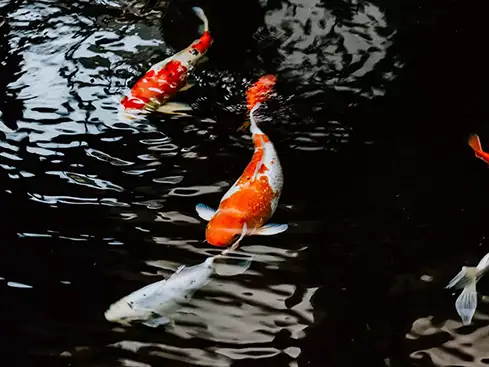
01 Jul 5 Things to Think About when Building a Koi Pond
Koi is an Asian fish species that many believe originated in China. Japan has cultivated the modern koi fish we know and love since the 1800s. Commercial and residential koi ponds have grown in popularity ever since then. Besides being aesthetically pleasing, koi ponds can also add a sense of tranquility to any outdoor space or indoor lobby. Before you start making plans for a koi pond, there are several details to take into consideration. Today, we will cover five essential things to consider when building a koi pond.
How Big Are You Thinking?
Look at your available space and measure your koi pond’s optimal dimensions (length, width, and depth). Keep in mind that koi fish can grow up to three feet long, so you must have a big enough pond to accommodate them once they mature.
The volume capacity of a small koi pond should be no less than 500 gallons of water, equating to roughly 16.5 square feet of space. A general rule of thumb is to have one koi for every 250 gallons of water to ensure the fish do not feel too cramped.
Is the Area Shaded?
Koi fish can only tolerate up to six hours of direct sunlight daily, so finding the right place for an outdoor koi pond is crucial. If you cannot find a good shady area, plant some shade trees or shrubbery to provide the necessary shade for your pond. Avoid building the pond near pine trees or fruit trees to reduce the potential debris buildup inside it.
How Will You Keep the Temperature Consistent?
Koi fish are usually hardy enough to thrive in cold water, but they tend to be most comfortable in water temperatures ranging between 60 and 70 degrees Fahrenheit. If you have enough space, plan to make some sections of the koi pond deeper than others to give the fish plenty of room to regulate their body temperatures. You may also need a couple of solar-powered koi pond heaters to keep your fish comfortable in the winter.
New koi owners need to know about dissolved oxygen levels to ensure the health and safety of the fish. Sunlight and water temperature directly affect dissolved oxygen levels, so test the pond’s oxygen levels at different times of the day during the first couple of weeks.
Knowing the dissolved oxygen levels is important because warm water holds less oxygen than cold water. Fish tend to be active later in the day while the insects are out, so they need more oxygenated water. If your pond is four or more feet deep, you must have a koi pond aerator, fountain, or waterfall to circulate the water, but even small ponds benefit from having an aeration system.
Have you Considered the Lilies?
We recommend adding water lilies and other aquatic pond plants to your koi pond. Water lilies provide shade, naturally attract insects for the koi to eat, and offer cover to hide from predators. Additionally, water lilies keep blooming algae at bay due to the plentiful shade on the water’s surface. Aquatic plants can cover up to 70 percent of the pond’s surface to maintain the longevity of your freshwater ecosystem.
Aquatic plants add beauty to koi ponds but are also an essential part of the food web. Many of these plants act like a sponge by filtering out excess sediment and pollutants in the water. A vital thing that aquatic plants do is help oxygenate the water and prevent shoreline erosion.
How Will You Protect the Fish from Predators?
There are multiple ways to protect your koi from natural predators. One of the easiest ways to deter pests such as raccoons is to build your pond with steep sides all the way around. Making it challenging for wildlife to reach the fish in the first place will give them ample time to react to approaching predators.
Koi fish are gorgeous, but their bright colors make them quite conspicuous. Water lilies and shade offer protection throughout the day from most aerial predators, such as seagulls. Having a deeper pond allows your fish to swim deeper if they have to hide. While a two-foot deep pond may be sufficient sometimes, a four-foot deep koi pond is often a better option.
Conclusion
Remember that you are always welcome to contact us if you need help with your koi pond. We are happy to help you think through some things before committing to building a koi pond. Let your imagination be your guide, and start creating your dream koi pond today. Although we do not construct koi ponds, we provide professional koi pond maintenance services to help your fish stay happy and healthy. No matter where you are in the process, you can count on Aquatic Gardens for your commercial koi pond service needs.
Get started today on a gorgeous and well-preserved koi pond by visiting our website, which will give you everything you need to know about building and maintaining your pond.



